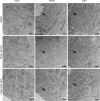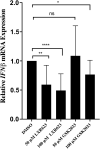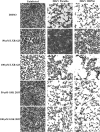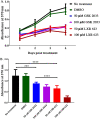The liver X receptor agonist LXR 623 restricts flavivirus replication
- PMID: 34162308
- PMCID: PMC8259867
- DOI: 10.1080/22221751.2021.1947749
The liver X receptor agonist LXR 623 restricts flavivirus replication
Abstract
The vector-borne flaviviruses (VBFVs) are well known for causing great misery and death in humans worldwide. The VBFVs include those transmitted by mosquitos, such as Zika virus (ZIKV), dengue virus; and those transmitted by ticks including the tick-borne flavivirus serocomplex and Powassan virus (POWV). Two of our recent reports showed that intracranial POWV infection in the reservoir host, Peromyscus leucopus, was restricted and caused no overt clinical disease. Several modes of analyses suggested activation of the LXR pathway. Activation of the LXR pathway leads to increased efflux of cholesterol from cells and consequent disturbances in membrane biogenesis. Because VBFV replication is dependent on membrane biogenesis, we evaluated the effect of an LXR agonist (LXR623) on POWV and ZIKV infection and observed that the compound impaired permissive replication of both viruses in a human neuroblastoma SK-N-SH cell line. The LXR agonist resulted in failure of the viruses to induce ER expansion and elaborate vesicle formation, suggesting that the efflux of cholesterol was part of the antiviral mechanism. We also observed that the LXR agonist contributed to the mechanism of virus suppression by increased expression of mRNAs encoding for the antiviral cytokines CXCL10, RANTES and IFN1β. In sharp contrast, a LXR antagonist (GSK2033) had no significant effect on VBFV replication. We conclude that LXR623 impairs flavivirus replication by stimulating cellular antiviral factors.
Keywords: Flavivirus; LXR 623; Powassan virus; Zika virus; liver X receptor; virus restriction.
Conflict of interest statement
No potential conflict of interest was reported by the author(s).
Figures








Similar articles
-
Viperin Restricts Zika Virus and Tick-Borne Encephalitis Virus Replication by Targeting NS3 for Proteasomal Degradation.J Virol. 2018 Mar 14;92(7):e02054-17. doi: 10.1128/JVI.02054-17. Print 2018 Apr 1. J Virol. 2018. PMID: 29321318 Free PMC article.
-
Activation of the Liver X Receptor Pathway Inhibits HBV Replication in Primary Human Hepatocytes.Hepatology. 2020 Dec;72(6):1935-1948. doi: 10.1002/hep.31217. Hepatology. 2020. PMID: 32145089
-
Neuroinvasive Flavivirus Pathogenesis Is Restricted by Host Genetic Factors in Collaborative Cross Mice, Independently of Oas1b.J Virol. 2023 Jul 27;97(7):e0071523. doi: 10.1128/jvi.00715-23. Epub 2023 Jun 13. J Virol. 2023. PMID: 37310228 Free PMC article.
-
Lipids and flaviviruses, present and future perspectives for the control of dengue, Zika, and West Nile viruses.Prog Lipid Res. 2016 Oct;64:123-137. doi: 10.1016/j.plipres.2016.09.005. Epub 2016 Oct 1. Prog Lipid Res. 2016. PMID: 27702593 Review.
-
Powassan Virus: An Emerging Arbovirus of Public Health Concern in North America.Vector Borne Zoonotic Dis. 2017 Jul;17(7):453-462. doi: 10.1089/vbz.2017.2110. Epub 2017 May 12. Vector Borne Zoonotic Dis. 2017. PMID: 28498740 Free PMC article. Review.
Cited by
-
Identification of stage-related and severity-related biomarkers and exploration of immune landscape for Dengue by comprehensive analyses.Virol J. 2022 Aug 2;19(1):130. doi: 10.1186/s12985-022-01853-8. Virol J. 2022. PMID: 35918744 Free PMC article.
-
Endosomal Cholesterol in Viral Infections - A Common Denominator?Front Physiol. 2021 Nov 11;12:750544. doi: 10.3389/fphys.2021.750544. eCollection 2021. Front Physiol. 2021. PMID: 34858206 Free PMC article. Review.
-
Targeting ABCG1 and SREBP-2 mediated cholesterol homeostasis ameliorates Zika virus-induced ocular pathology.iScience. 2024 Feb 2;27(3):109088. doi: 10.1016/j.isci.2024.109088. eCollection 2024 Mar 15. iScience. 2024. PMID: 38405605 Free PMC article.
-
Advances in antiviral strategies targeting mosquito-borne viruses: cellular, viral, and immune-related approaches.Virol J. 2025 Feb 4;22(1):26. doi: 10.1186/s12985-025-02622-z. Virol J. 2025. PMID: 39905499 Free PMC article. Review.
-
Integrated re-analysis of transcriptomic and proteomic datasets reveals potential mechanisms for Zika viral-based oncolytic therapy in neuroblastoma.F1000Res. 2024 May 21;12:719. doi: 10.12688/f1000research.132627.3. eCollection 2023. F1000Res. 2024. PMID: 38903860 Free PMC article.
References
MeSH terms
Substances
LinkOut - more resources
Full Text Sources
Medical
